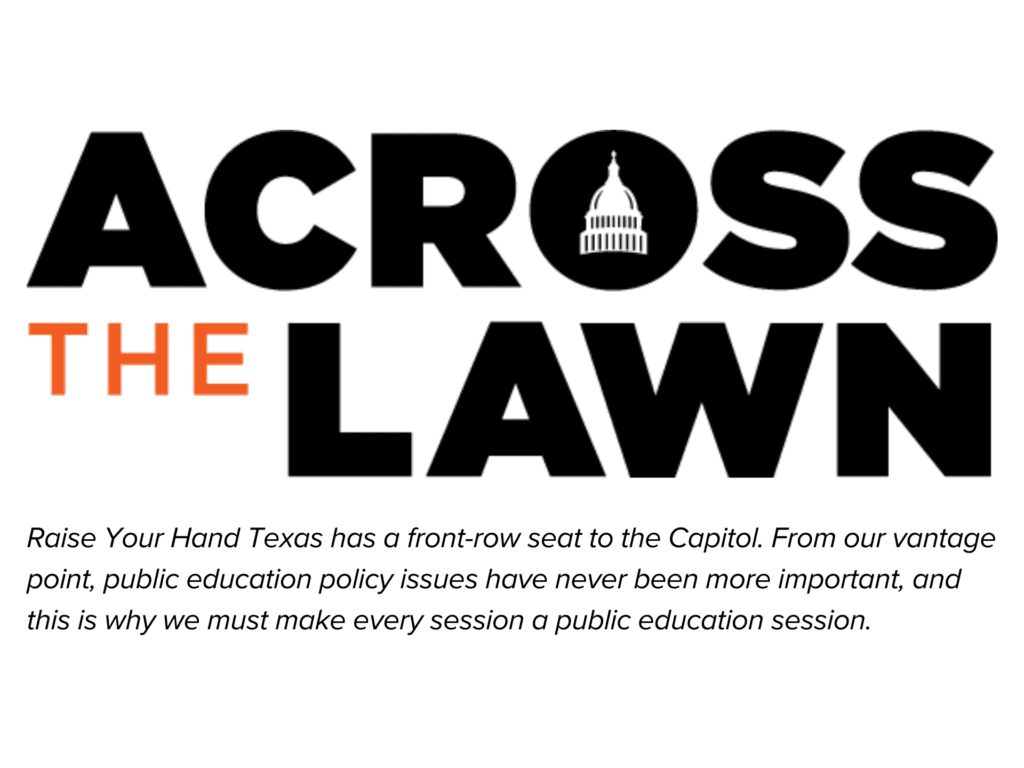
categories
Across the Lawn – January 31, 2025

January 31, 2025

One Thing to Do: Learn More About the Texas Education Agency Budget
Set a calendar reminder to tune into the Senate Finance Committee (SFC) on Monday, February 10, at 10:00 a.m. The committee will hear the proposed budget for the Texas Education Agency (TEA) and the Teacher Retirement System of Texas.
The initial Senate recommendations include $5.3 billion in additional funding for public education. This includes a $4.9 billion increase for teacher pay and changes to the Teacher Incentive Allotment. The Senate also includes $400 million for school safety and $1 billion for a school choice program in the second year of the biennium, 2027.
Five Things to Know:
1. Governor Abbott to Give 2025 State of the State Address
Governor Greg Abbott announced the 2025 State of the State address will be on Sunday, February 2, at 5:00 p.m. The address will be broadcast on Nexstar Media Group Inc. television stations across Texas. The Governor will most likely declare his emergency items for the 89th Legislature.
“Texas is the blueprint for America’s future,” said Governor Abbott. “This 89th Legislative Session brings new opportunities for the Texas Legislature and statewide leaders to strengthen our national and global position as the beacon of economic opportunity, prosperity, and individual liberty. From becoming the eighth-largest economy in the world to safeguarding the freedoms that make Texas great, we are working tirelessly to accomplish what seems impossible. Working together, we will continue to build a stronger Texas for generations.”
2. Senate Committee on Education K-16 Votes SB 2 (Vouchers) from Committee, 9-2
The Senate Committee on Education K-16 heard its first bill of the 89th Legislature this Tuesday, January 28. SB 2 by Sen. Creighton was voted out by committee with a vote of 9-2. The bill is expected to be heard on the Senate floor early next week.
SB 2 allows every Texas student to apply for an Education Savings Account (ESA), whether in public school, private school, or homeschool. If the applications do not exceed the program’s capacity (currently estimated to be $1 billion in 2027), then all students are accepted. If applications exceed the capacity, then 80% of the positions will be filled by lottery by those students who previously attended public school and are either from low-income households or have a disability. Each participating student will receive at least $2,000, or if a family elects to enroll their student in a private school, the student will receive $10,000 ($11,500 if the student has a disability).
Note: Low income is defined in the bill as 500% of the federal poverty guideline or a family income of $160,750 for a family of four.
The fiscal analysis also assumes the cost of the ESA program is $1 billion in 2027, but it escalates to $3.2 billion in 2028, $3.8 billion in 2029, and $4.6 billion in 2030.
3. Lt. Governor Patrick Releases First Round of Priority Bills
Lt. Gov. Dan Patrick issued this statement on Wednesday, January 29, announcing the first round of his top 40 priority bills for the 89th regular legislative session:
The list includes the following education-related bills:
- Senate Bill 2 – Providing School Choice
- Senate Bill 10 – Placing the Ten Commandments in School
- Senate Bill 11 – Protecting the Freedom to Pray in School
- Senate Bill 12 – Establishing a Parental Bill of Rights in Public Education
- Senate Bill 13 – Guarding Against Inappropriate Books in Public Schools
- Senate Bill 24 – Educating Texas Students on the Horrors of Communism
4. Texas Education Agency Annual Report Highlights Increase in Uncertified Teachers
The Texas Education Agency released its 2024 Annual Report. The report provides a comprehensive overview of our public schools, including school funding, STAAR, special education, and school safety.
According to the report, “Texas public schools hire approximately 50,000 teachers annually, with about one-third being rehires of experienced teachers. Among the estimated 30,000 hires that are new to the profession each year, an increasing number are uncertified.”
During the 2023-24 school year, 56% of new teachers were uncertified, 23% were certified under an alternative certification program, and only 20% were certified through traditional educator preparation programs.
Raise Your Hand Texas strongly supports the following teacher workforce initiatives this legislative session:
- Support teacher retention through increased compensation and benefits packages of at least $15,000
- Invest in teacher recruitment strategies, including scholarships for aspiring teachers
- Strengthen teacher development by raising the standards for all education preparation pathways and providing meaningful professional development opportunities
5. Senate Committee on Finance Discusses $51 Billion in New and On-Going Property Tax Relief
Since 2019, the Texas Legislature has passed various forms of property tax relief for homeowners and businesses. These policies include tax rate reductions occurring automatically based on property value growth, additional rate reductions based on the amount of appropriations each legislative session, and increases to the homestead exemptions.
The property tax relief given through these various mechanisms is not a one-time cost for our state budget. It is ongoing and substantial.
For instance, last legislative session $17.9 billion was appropriated for property tax relief—a number that has now been revised to $22.7 billion for the 2024-25 biennium—a cost that will need to be budgeted for this session and every session moving forward in order to continue the property tax relief.
When you take all property tax relief granted since 2019, and the new $3 billion proposals for this legislative session into account, the price tag for all of our state’s property tax relief programs is now $51 billion for the biennium.
To put this amount into perspective, Texas currently ranks 46th in the nation in per-student spending, about $4,400 below the national average. In order for Texas to rank 25th in the country–just the national average–our state needs to increase funding by about $48 billion for the biennium.



